Chief Medical Officer's Annual Report 2014-15
The Chief Medical Officer Annual Report 2014 -2015 explores the challenges that face doctors today.
The Health of the Nation - Executive Summary
This is an Executive Summary containing highlights of the Health of the Nation report. The data and graphs are evidence of both the successes we have already achieved in Scotland and the areas where we need to drive further improvement.
The full report can be found at www.gov.scot/cmoannualreport201415part2.
Health Improvement:
Premature mortality has reduced substantially in recent years, down 38% since 1994.
Death rates (<75y) per 100,000 population by selected causes, Scotland 1994-2014
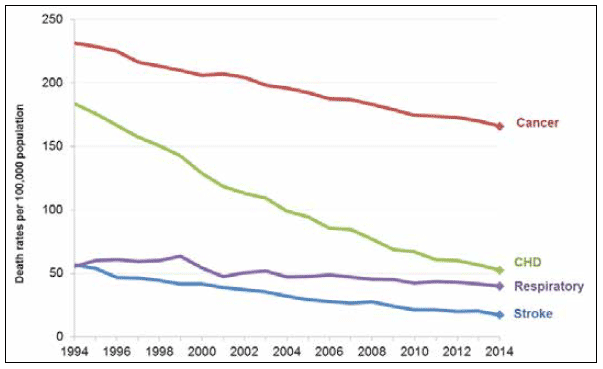
Multimorbidity. The Scottish Health Survey shows that 46% of adults (aged 16 and over) have at least one long-term condition. There are more people in Scotland with multimorbidity below 65 years than above.
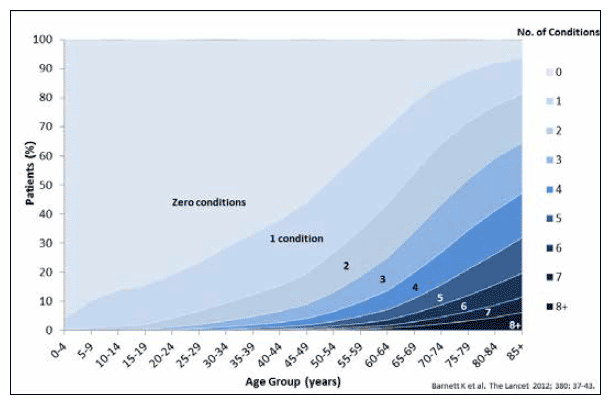
Obesity. The Scottish Health Survey (SHeS) 2014 found that almost two-thirds of adults (65%) in Scotland were overweight or obese (Body Mass Index (BMI) > or = 25), with 28% classified as obese (BMI > or = 30). In addition, around one in six (17%) of children were at risk of obesity, with a further 14% at risk of overweight. There has been a significant increase in the proportion of adults aged 16 to 64 categorised as obese, from 17% in 1995 to 27% in 2014, although the level has remained fairly constant since 2008. Women have higher rates of obesity than men (29% compared to 26% in 2014) with obesity rates highest in areas of greater deprivation. This pattern is particularly marked among women with women in the most deprived quintile in 2014 having obesity rates 16 percentage points higher than women in the least deprived quintile.
Obesity rates (adults) by gender and deprivation, Scotland 2003-2014
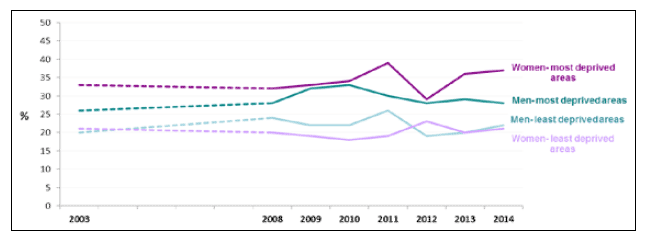
Children from the most deprived areas are more likely to be overweight or obese than to those from the least deprived areas.
The Projected Prevalence of Obesity in Primary 1 Children in Scotland for Scottish Index of Multiple Deprivation Quintiles 1 & 5 compared to Scotland as a whole: school years 2001/02 to 2019/20
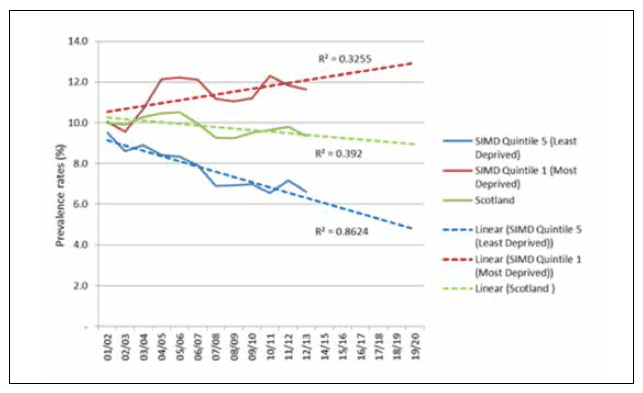
Poor diet continues to be a major driver of the obesity epidemic. The Supporting Healthy Choices (SHC) framework outlines the Scottish Government and the Food Standards Scotland ambition to work collaboratively with partners to improve Scotland's diet and tackle health inequalities.
Four core principles of SHC:
- Put children's health first in food-related decisions
- Rebalance promotional activities to significantly shift the balance towards healthier choices
- Support consumers and communities with education and information
- Formulate healthier products and menus across retail and out of home catering
Physical activity. There is strong scientific evidence that sufficient, regular physical activity is beneficial for the health of body and mind.
This infographic was developed from the UK Chief Medical Officers' 2011 Physical Activity Guidelines. It is designed for use by healthcare professionals but has been well received by many others and shared widely using social media.
In 2014, 63% of adults in Scotland met the guidelines on moderate or vigorous physical activity (MVPA) of at least 150 minutes of moderate, or 75 minutes' vigorous activity, or an equivalent combination of the two, per week. This figure has not changed significantly in the 2012-2014 period. Men are more likely to meet the physical activity guidelines than women (68% v 59% in 2014). Activity levels are significantly associated with age, with adherence in 2014 highest among adults aged 25-34 (79%), and steadily declining with increasing age, with the lowest proportion found among adults aged 75 and over (26%).
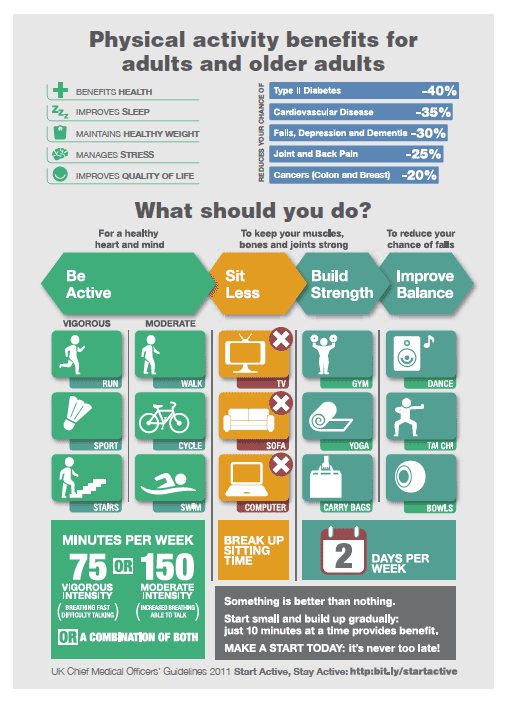
Alcohol continues to cause significant harm in Scotland. The scale of the problem is clear but the most recent data paints a mixed picture: consumption relatively stable, alcohol-related deaths up for the second year running and hospital admissions continuing to fall. There are clear links between alcohol and social deprivation. The UK CMOs' new consultation on guidelines for lower risk alcohol consumption were launched in January 2016.
The main recommendations are that men and women are advised not to regularly drink more than 14 units a week; to spread drinking over three or more days if drinking as much as 14 units a week; and there is no safe amount of alcohol that can be drunk during pregnancy.
https://consultations.dh.gov.uk/alcohol/uk-cmo-guidelines-review
Alcohol-related deaths by deprivation decile, Scotland 2014
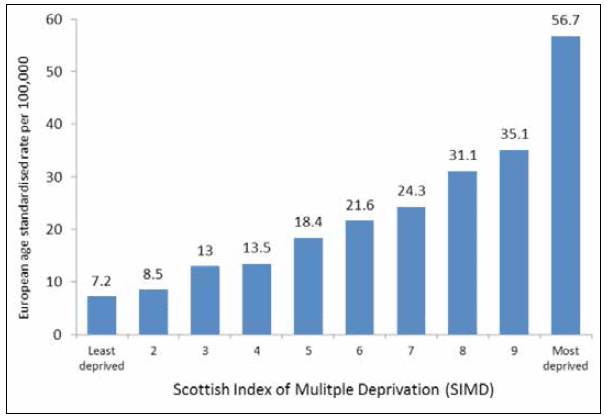
Smoking is the leading preventable cause of ill-health and premature death in Scotland, with half of all regular cigarette smokers estimated to die prematurely as a result of smoking. Smoking is associated with around a fifth of all deaths, and around 128,000 hospital admissions, per year in Scotland.
The decline in 2014 brings smoking prevalence in line with our projections towards the 2034 policy target (smoking prevalence of 5% or less by 2034). However, as with many other lifestyle factors significant inequalities remain: in the 20% most deprived areas 34% of adults smoke, compared to 9% in the least deprived areas.
Smoking prevalence: 1999-2014 and Projected smoking prevalence towards 2034 target1
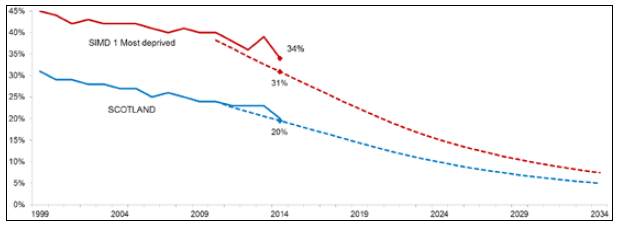
Cancer. Age-standardised cancer mortality rates have decreased by 20% since 1989, with a greater fall in males than in females (24% and 13% decrease, respectively). Cancers of the lung (4,117), colorectum (1,525), breast (976), prostate (906) and oesophagus (850) were responsible for more than half of the deaths from cancer in Scotland in 2014.
Cancer mortality rates, Scotland 1989-2014 (excluding non-melanoma skin cancer)
European Age Standardised Rate (EASR) per 100,000 population
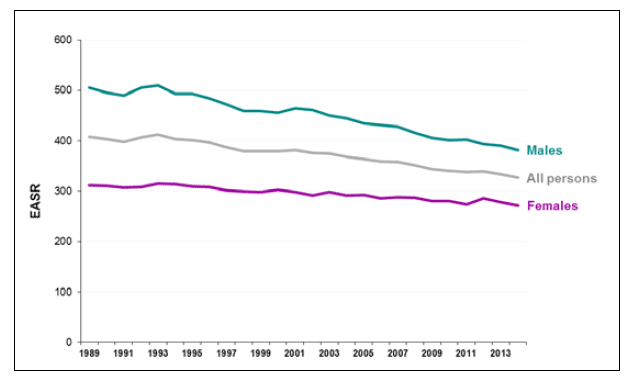
Mental health is one of the top public health challenges as measured by prevalence, burden of disease and disability, with around one in three people estimated to be affected by mental illness in any one year. In 2012-13, 26% of adults in the most deprived areas had a below average Warwick-Edinburgh Mental Wellbeing Scale score, compared to 6% of adults in the least deprived areas. The inequality gap has widened in recent years.
Suicide. There has been a 17.8% reduction in the suicide rate in Scotland over the period 2000-04 to 2010-2014, with the number of deaths by suicide in Scotland in 2014 the lowest in a single year since 1977.
Suicide rates, Scotland 1994-2014, European Age Standardised Rate
(EASR) per 100,000 population
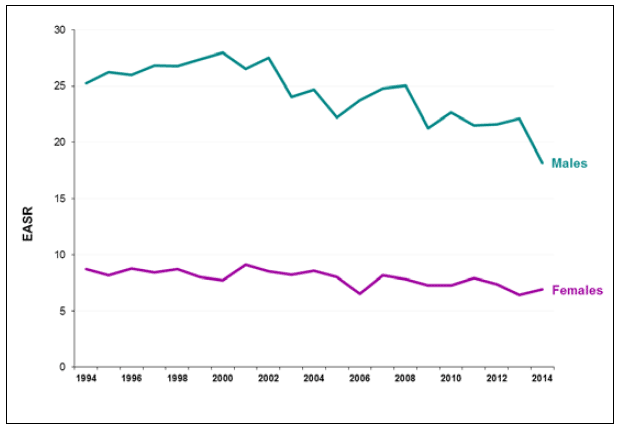
Contact
Email: Diane Dempster
There is a problem
Thanks for your feedback